《英美概况》教案3
- 格式:ppt
- 大小:1.25 MB
- 文档页数:55

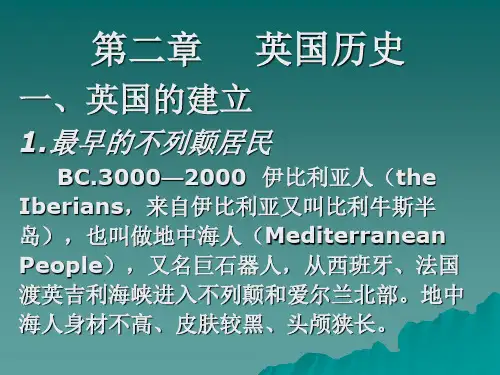
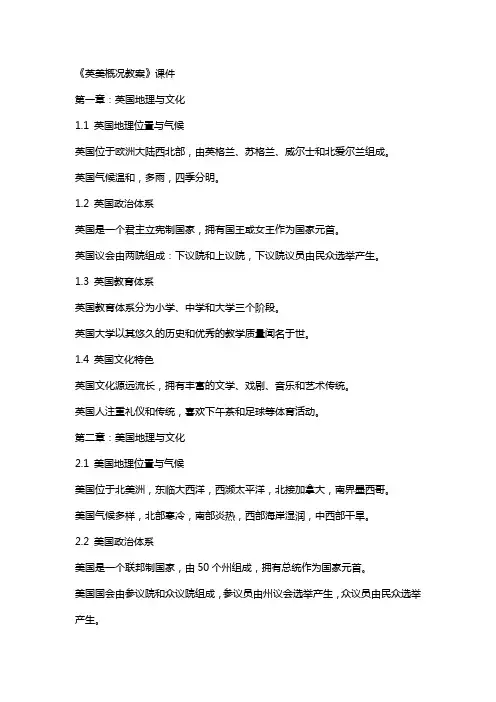
《英美概况教案》课件第一章:英国地理与文化1.1 英国地理位置与气候英国位于欧洲大陆西北部,由英格兰、苏格兰、威尔士和北爱尔兰组成。
英国气候温和,多雨,四季分明。
1.2 英国政治体系英国是一个君主立宪制国家,拥有国王或女王作为国家元首。
英国议会由两院组成:下议院和上议院,下议院议员由民众选举产生。
1.3 英国教育体系英国教育体系分为小学、中学和大学三个阶段。
英国大学以其悠久的历史和优秀的教学质量闻名于世。
1.4 英国文化特色英国文化源远流长,拥有丰富的文学、戏剧、音乐和艺术传统。
英国人注重礼仪和传统,喜欢下午茶和足球等体育活动。
第二章:美国地理与文化2.1 美国地理位置与气候美国位于北美洲,东临大西洋,西濒太平洋,北接加拿大,南界墨西哥。
美国气候多样,北部寒冷,南部炎热,西部海岸湿润,中西部干旱。
2.2 美国政治体系美国是一个联邦制国家,由50个州组成,拥有总统作为国家元首。
美国国会由参议院和众议院组成,参议员由州议会选举产生,众议员由民众选举产生。
2.3 美国教育体系美国教育体系分为小学、中学、高中和大学四个阶段。
美国大学以其多样性和创新性著称,拥有世界上最多的大学排名前100的名校。
2.4 美国文化特色美国文化多元且开放,拥有丰富的音乐、电影、科技和体育传统。
美国人注重个人主义和自由,喜欢户外活动、运动和社交聚会。
第三章:英国经济概况3.1 英国经济简述英国是发达国家之一,拥有强大的经济实力和先进的技术产业。
英国经济以服务业为主,特别是金融服务业在全球具有重要地位。
3.2 英国主要产业英国拥有发达的制造业,包括汽车、航空、制药等行业。
英国科技产业发展迅速,特别是在、生物科技等领域。
3.3 英国经济政策英国政府采取自由市场经济政策,鼓励企业创新和发展。
英国是欧盟成员国,与欧盟其他国家有着紧密的经济合作关系。
3.4 英国与他国的经济关系英国与美国、加拿大、澳大利亚等英语国家有着密切的经济合作关系。
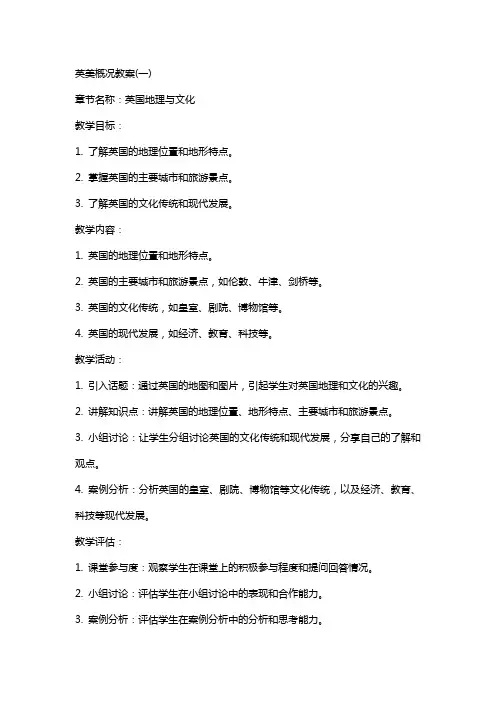
章节名称:英国地理与文化教学目标:1. 了解英国的地理位置和地形特点。
2. 掌握英国的主要城市和旅游景点。
3. 了解英国的文化传统和现代发展。
教学内容:1. 英国的地理位置和地形特点。
2. 英国的主要城市和旅游景点,如伦敦、牛津、剑桥等。
3. 英国的文化传统,如皇室、剧院、博物馆等。
4. 英国的现代发展,如经济、教育、科技等。
教学活动:1. 引入话题:通过英国的地图和图片,引起学生对英国地理和文化的兴趣。
2. 讲解知识点:讲解英国的地理位置、地形特点、主要城市和旅游景点。
3. 小组讨论:让学生分组讨论英国的文化传统和现代发展,分享自己的了解和观点。
4. 案例分析:分析英国的皇室、剧院、博物馆等文化传统,以及经济、教育、科技等现代发展。
教学评估:1. 课堂参与度:观察学生在课堂上的积极参与程度和提问回答情况。
2. 小组讨论:评估学生在小组讨论中的表现和合作能力。
3. 案例分析:评估学生在案例分析中的分析和思考能力。
章节名称:美国地理与文化教学目标:1. 了解美国的地理位置和地形特点。
2. 掌握美国的主要城市和旅游景点。
3. 了解美国的文化传统和现代发展。
教学内容:1. 美国的地理位置和地形特点。
2. 美国的主要城市和旅游景点,如纽约、华盛顿、旧金山等。
3. 美国的文化传统,如多元文化、宗教、节日等。
4. 美国的现代发展,如经济、教育、科技等。
教学活动:1. 引入话题:通过美国的地图和图片,引起学生对美国地理和文化的兴趣。
2. 讲解知识点:讲解美国的地理位置、地形特点、主要城市和旅游景点。
3. 小组讨论:让学生分组讨论美国的文化传统和现代发展,分享自己的了解和观点。
4. 案例分析:分析美国的多元文化、宗教、节日等文化传统,以及经济、教育、科技等现代发展。
教学评估:1. 课堂参与度:观察学生在课堂上的积极参与程度和提问回答情况。
2. 小组讨论:评估学生在小组讨论中的表现和合作能力。
3. 案例分析:评估学生在案例分析中的分析和思考能力。
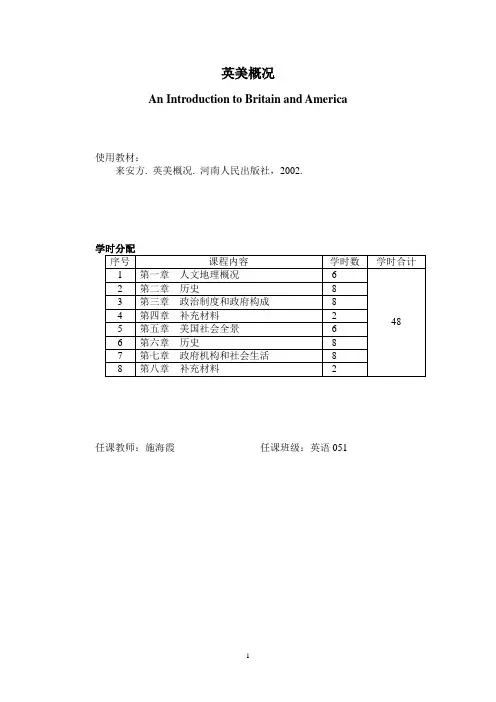
英美概况An Introduction to Britain and America使用教材:来安方. 英美概况. 河南人民出版社,2002.任课教师:施海霞任课班级:英语051Teaching Objectives: This course is mainly to make known to the students theBritish politics, culture as well as society at large, and itsposition in the world as far as its long history is concerned.(It might be difficult for the students to understand theBritish political system, its people and its culturaldifferences because of religious reasons. Thus, someemphasis should be laid on its religious background.)Time Allocation: 4 periodsFocal Points: The Country of today, Understanding of Different NamesI. General IntroductionGreat Britain, the dominant industrial and maritime power of the 19th century, played a leading role in developing parliamentary democracy and in advancing literature and science. At its zenith (极盛时期), the British Empire stretched over one-fourth of the earth's surface. The first half of the 20th century saw the UK's strength seriously depleted in two World Wars. The second half witnessed the dismantling (瓦解)of the Empire and the UK rebuilding itself into a modern and prosperous European nation.As one of five permanent members of the UN Security Council (China, France, Russian Federation, United Kingdom and United States), a founding member of NATO (North Atlantic Treaty Organization), and of the Commonwealth, the UK pursues a global approach to foreign policy; it currently is weighing the degree of its integration with continental Europe. A member of the EU (European Union), it chose to remain outside the Economic and Monetary Union for the time being. Constitutional reform is also a significant issue in the UK. The Scottish Parliament, the National Assembly for Wales, and the Northern Ireland Assembly were established in 1999, but the latter is suspended due to bickering (argue) over the peace process.Government United KingdomOfficial name: The United Kingdom of Great Britain and Northern Ireland. Form of government: Constitutional monarchyLegislature:Bicameral legislature with two legislative houses1.House of Lords [675 members (consisting of approximately500 life peers, 92 hereditary peers and 26 clergy);2.House of Commons (646 seats since 2005 elections;members are elected by popular vote to serve five-yearterms unless the House is dissolved earlier)Note:1) Elections: House of Lords - no elections;House of Commons - last held 5 May 2005 (next to be heldby May 2010)2) Election results: House of Commons - percent of vote by party - Labor35.2%, Conservative 32.3%, Liberal Democrats 22%, other 10.5%; seatsby party - Labor 356, Conservative 197, Liberal Democrat 62, other 31Capital: London, England.National holiday:the UK does not celebrate one particular national holiday Constitution:unwritten; partly statutes, partly common law and practice Chief of state: Sovereign (君主).Present Queen: Elizabeth II (since February 1952);Head of government: Prime Minister.Present Prime Minister: Anthony (Tony) Blair (since 2 May 1997) (Labor Party) Cabinet:Cabinet of Ministers appointed by the prime minister; National Anthem: God Save the King (Queen)God Save the QueenGod save our gracious Queen,Long live our noble Queen,God save the Queen!Send her victorious,Happy and glorious,Long to reign over us,God save the Queen!O lord God arise,Scatter our enemies,And make them fall!Confound their knavish tricks,Confuse their politics,On you our hopes we fix,God save the Queen!Not in this land alone,But be God's mercies known,From shore to shore!Lord make the nations see,That men should brothers be,And form one family,The wide world ov'erFrom every latent foe,From the assasins blow,God save the Queen!O'er her thine arm extend,For Britain's sake defend,Our mother, prince, and friend,God save the Queen!Thy choicest gifts in store,On her be pleased to pour,Long may she reign!May she defend our laws,And ever give us cause,To sing with heart and voice,God save the Queen!---What is “Commonwealth”?Commonwealth of Nations, worldwide association of nations and their dependencies, whose members share a common commitment to promoting human rights, democracy, and economic development. All members accept the British monarch as the symbolic head of the Commonwealth. All but one, Mozambique, were once associated in some constitutional way with either the former British Empire or with another member country. The association was formerly known as the British Commonwealth of Nations, but today is referred to simply as the Commonwealth.About 1.7 billion people live in the 54 independent nations and the more than 20 dependencies that make up the Commonwealth. Only independent nations can be considered full members; they are all fully sovereign and in no way subordinate to Britain. Dependencies of Commonwealth nations are also included in the Commonwealth, although not as full members, and can participate in many Commonwealth activities. Commonwealth members share many customs and traditions as a result of their association with Britain. Many have parliamentary systems of government on the British model, and their judicial and educational institutions are often similar to those in Britain. English is an official language of many members of the Commonwealth. Since 1977 the second Monday in March has been celebrated as Commonwealth Day; on that day the British monarch, as the head of the Commonwealth, presents an annual message to all member countries.Almost all members of the Commonwealth were once ruled by Britain as part of the British Empire. Some of them, such as Australia and Canada, were largely settled by British people. Others, such as India and Nigeria, were areas where British administrators governed a large non-British population.The Commonwealth is a flexible and often informal association. Its main function is to encourage communication and cooperation among its diverse members, with their different needs and concerns. In 1965 the Commonwealth Secretariat was established in London to serve as a clearinghouse for the exchange of information. The Secretariat (秘书处)is headed by the Commonwealth secretary general and is responsible for carrying out programs formulated during the various meetings. The secretary general is elected by the Commonwealth heads of government from among the many Commonwealth diplomats and ministers. The Commonwealth Foundation provides financial and other support to professional associations and non-government organizations, enabling these groups to travel to other Commonwealth countries to work together.The heads of Commonwealth governments meet to discuss common problems every two years at Commonwealth Heads of Government Meetings (CHOGM). In addition, ministers and experts in education, health, finance, science, law, women’s issues, youth affairs, and various technical fields meet frequently to consult and act on important issues.V olume I The Great BritainChapter One Land and PeopleSection 1: The British Isles and Great Britain1.Brief history of British people and languageBritain was part of the European Continent many centuries ago. It was later washed off by seawater and became an island.i. The Stonehenge left by the Iberians is the possible origin of English history.The Iberianswere the first invaders who were dark-haired “ Mediterranean” race. (3,500years ago without any written record)ii. The Celts, also called the Britons who were said to have come from eastern and central Europe (France, Belgium and Southern Germany), were regarded as the natives of Great Britain. The fore fathers of the Celts immigrated into Britain in about 7th century B.C.iii. The Romans led by Julius Caesar went across the Channel and invaded Britain in 55 B.C. but in vein. The Romans conquered the Celts in England in the first century A.D. and controlled for about 400 years. The Roman civilization was brought to Britain: language, town, temples, theatres and fine buildings.iv. Germanic tribes from North Europe: Angles, Saxons, Jutes invaded it 410 A.D.The Angles gave their name to England (Angle’s land) and the English people.v. Few hundred years later, the Danes from the North –East of Europe fought against one of the earliest and greatest of English kings, Alfred, about 900A.D. In 1016 the Danish leader was put on the throne and began to ruleEngland. Edward the Confessor, the Danish king was a pious Christian built the famous Westminster Abbey where he was buried. It is well known for its Poet’s Corner, which is a cemetery for distinguished English poets. All the coronation ceremonies ever since the Norman Conquest have been held in the Abbey.vi. Finally there came the great Norman invasion. Normans (“North-men”) were originally from Scandinavia. Led by William (“William the Conqueror”, “Duke William of Normandy”), the Normans from France conquered England in 1066.Origins of the British People: table of invasions In chronological orderInvaders ContributionIberians ?Celts (Gaels, Britons) Scottish and Irish race and culture, Welsh race and cultureRomans Latin alphabet and civilizationGermanic tribes(Angles, Saxons, Jutes) English race and languageDanes some peculiarities of dialect in north and east EnglandNormans (French-Speaking) Final unification of England. Great administrative progress.English civilization permanently linked toFrance rather than to Scandinavia. Foundationof aristocracy.Language:Indo-European language (by Neolithic people wandering in Asia and Europe)↓North Europe →Germanic language (many tribes) & Other languages↓Anglo-Saxon: Old English (5th---12th c.) & brothers in North Europe: Germanlanguage↓↓1066 Norman Conquest↓Middle English (12th---15th c.)↓printing introduced to England( Samuel Johnson, 1stdictionary)↓expansion of the English Empire↓RenaissanceModern English2.Climate and weather:i.Why does weather become a general topic for daily conversation?Britain is well known for its changeable weather. As a result, English people have evolved the habit of discussing the weather whenever there is the possibility.The temperature in Britain is “strange”because it is “incompatible”with the latitude: in winter the temperature is “too high” (3-10), while in summer it is “too low” (25-32).ii.Some English people say, “Other countries have a climate; in England we have weather.”Climate: average, certain area long period weather conditionWeather: day to day particular areaThe characteristics of English weather:a. Changeable: One can experience 4 seasons in the course of a single day.A warm spring morning →about 1 hour later: black clouds →rain,drizzle or pouring down→at middy: temperature down, wintry cold→in the late afternoon: the sky will clear, and sun shines→summer before darkness fallsSo the British people are cautious. Even when it is fine, they will bring an umbrella with them.b. Abundant rain: almost half of the days are rainy days, much of whichcomes down in drizzle.c. No striking deference between seasons.d. Foggy in London: smog caused by the pollution of industries, coal used forcooking or heating. Now the visibility in London is not as bad as it was before.iii. May Day festival is one of the major English annual festivals with a long history is somewhat like the Chinese festival of Pure Brightness when Chinese people “walk on the green grass “ to welcome the return of spring.3.Map of England:i. The full name of the country & some of the commonly used ones.The United Kingdom of Great Britain and Northern IrelandU.K. / the United KingdomGreat Britain / Britain (the biggest island among the British Isles, which includes the Northern Ireland and the Republic of Ireland), which does not include the Northern Ireland. But since it covers the most area of the country, it is the name indicating the whole country.England (The importance of England is so great that itself can mean the whole country)ii.The composition of the whole country:The total area of the U.K. is only a little more than 244,700 with a populationof some 57.4 million (1990)Area population terrainEngland 85% plainGreat Britain Scotland 10% highland/lowland/mountain chainWales 5% mountain Northern Ireland highlandMountains and highlands: sparsely populatedLowland and plain: densely populatedPhysiographic features: the Highland Zone of the north and west and the Lowland Zone of the south and southeast.iii.Some important places to remember:The Pennies, also known as the “Backbone of England”, are kind of “upland”in the northern part of England.The Lake District of Cumbria lies on the western side of the Pennies. Some of the famous English poets, such as William Wordsworth, Samuel Coleridge and Robert Southey got their inspiration from and their poems sang high praise of the scenery of this district. They were called the Lake Poets in the history of English literature.The Thames River is the second longest and most important river in U.K. Itruns through the Midland of England, which is the most important plain in Britain.It is very favorable for transportation. London and the University town, Oxford, are situated on the river.iv.The neighbors of U.K. on the map:The only country U.K. shares a land border with: the Republic of IrelandTo the north of U.K.: Iceland and NorwayAcross the North Sea: Holland, Germany, Denmark and NorwayTo the southeast and across the English Channel: FranceTo the south across the Atlantic Ocean and the Bay of Biscay: Spain and PortugalOn the west corresponding side of the Atlantic Ocean: America & Canada4. Why is English qualified as an international language?The quality of the English language was greatly improved by extensive borrowing, which enabled it to have a large vocabulary for various purposes. The expansion of the British Empire helped to spread English into many countries and places all over the world. It is spoken as the native language in the US, Britain, Ireland, Australia, New Zealand, Canada, the Caribbean and South Africa. It is also used as the second language for certain officials as well as social, commercial and educational activities in India, Pakistan, Nigeria, Kenya, the Philippines Singapore and Ethiopia. It is also one of the working languages of the United Nations. English is the primary medium for modern science and technology. Almost all the research papers are published in English besides their native tongue. The combined GNP pf the English-speaking countries and places takes up more than half of the world’s total.Section 2: People and the State1.What is UK. Most well known for?i.The first country to establish the Parliament which finally led to partypoliticsii.The first country to witness the bourgeois revolution which resulted in the founding of a democracy with a constitutional monarchyiii.The first country to start the Industrial Revolution which contributed to the establishment of British Empire “on which the sun never set”iv.The British government system, known as the Westminster System, provided the basic framework for many other western democraciesincluding the US to model on.v.The English language is one of the most important languages in the world.2.Party politics:2 major parties: i. the Conservatives ←the Tory Partyii. the Labor ←Whig Party (Liberal), Fabian Society, Trade Unions& some minor parties…i.The Party of the Right is the Conservative Party. The Conservatives, alsocalled Tories, are supported by most landowners and businessmen (middleclass and all the upper-middle class--- professional and managerial people),i.e. those who have something to “conserve”(keep from change, loss ordestruction). They tend to uphold the existing authority.Doctrines held by the Conservative:a.believe in “ private enterprise”b.be against too much government control of industryc.show a willingness to accept controls and changes when it is inevitableii.The Party of the Left is the Labor Party, sometimes called socialists. It was formed with the strong support of the trade unions so as to give theworkers political power. (Working class, middle and lower-middle class) Their central believes:a.The businessman cannot be trusted to serve the best interests of thecommunity.b.The supervision of industry (especially big enterprises) by the governmentcompete nationalization, i.e. state ownership of industry.c.Socialism: to even out the distribution of wealth so that everyone has afair share.If the economic situation were rosy, the Labor Party would have less chance to win. If the economic situation is gloomy and many people want changes as a way out, the Labor Party would stand a good chance of winning the election.There is no need to apply for membership in a party. If a person chooses to support a Party’s program in the general election, he isautomatically considered as a member of the Party.3.Basic concept and function of the British Government:i. Central Government:a. Monarch (king or queen)--- head of the state, symbol of the national unityb. Parliament (law-making body)--- (approved by the queen) the House ofCommons & the House of Lordsc. the Cabinet (and various departments)--- the executive branch, called “HerMajesty’s Government”or “the government”, responsible to theParliament, appointed by the Queen, headed by the Prime minister →ministers (head of each department) →civil servantsAct and bills passed by the Parliament must get the queen’s approval before going into effect, i.e. she has the right to veto…There is no knowing what will happen if the Queen does not agree with the government, but fortunately she has given her consent to all governmentdecisions.iii.Local government:Central Government →county government→district governmenta.The largest local administrative areas are called counties (once called“shires”) e.g. Yorkshire, Lancashire, Wiltshire.b.The county is subdivided into a number of districtsc.Cities have become districts of the county, e.g. The City of Manchesternow is one of the districts of the County of Greater Manchester.d.“borough” means almost the same as city. Sometimes a city may include anumber of boroughs because the city is very large or the city keepsexpanding in size.The local government is called the “council”,headed by a Mayor or Lord Mayor.4. Constitution:There is no written constitution in UK. The British constitution has evolved and grown up slowly as a result of countless Acts of Parliament. It is embodied in a number of separate laws:i.Acts of Parliament:mon law: a. tradition/ conventions of the Anglo-Saxonb. verdicts in dealing with specific cases by the Englishlaw courts (by the jury)iii. Equity law: principles of justice outside common law or statute law, used tocorrect laws when these would apply unfairly inspecial circumstancesiii.European Community legislation5. Police and Justice:i. The English law courts are divided into 3 tiers, which make up the British judicial branch.a. Magistrate’s Courts: Every town or borough has one. It is the lowest court dealing with minor cases by solicitors or counsels. It can only try people for minor, not very serious offences: sentences of not more than 6 months or fine of not more than 400 pounds. It is also known as “ Courts of Summary jurisdiction” or “Petty Sessions” (courts held by magistrates to hear certain offences without a jury). The judges of magistrate’s courts, “Magistrates”or “Justices of the Peace”(J.P), are always ordinary citizens (well-known) and have very little training in law and receive no salary.b. Circuit Courts: regular journey made by judges and barristers to town. Cases are dealt by barrister / lawyers & circuit judges.c. High Courts: Cases dealt by barristers / lawyers & high court judgesii. The profession of lawyers:a.Solicitor: junior lawyer--- To be a solicitor one can only serve at magistrate’scourts: work apprentice in firm of a solicitor →pass the examination of the law societyb.Barrister: senior lawyer--- To be a barrister one should:Be a member of one of the 4 Inns of Court→pass the Bar Exam →keepstudy several years in the Inn. (earn very little money / life is difficult)If a barrister is successful enough, he will be appointed circuit court judge orhigh court judge.iii. English & American legal principal: “ No prison without trial” i.e. No one is to be punished by law without a just trial by his fellow citizens--- the jurors, also known as jurymen or sworn men, hear evidence and give verdict. Before Henry II (12th century), jurors acted as witnesses for trials by ordeals or duels. A jury is the body of persons (in US and GB 12) who swear to give a decision (verdict) on issues of fact in a case in a court of justice. To serve as a juror in a jury is a citizen (local resident)’s obligation, not privilege. The jury represents the people, and it is the jury, not the judge, which decides whether an accused person is guilty or not.What is known as “cross-examination?”After the jury takes its place in the “jury box”, the trial begins. The prosecution builds up its case by presenting evidence and witnesses. The prosecuting barrister, or counsel, will question the witnesses so that a story of the supposed crime can be built up for the jury to believe. The defendant’s lawyer may also question the witnesses. This is known as “cross-examination”.iv.Police forces:“Do you wish to say anything? You are not obliged to say anything unless you wish to do so. But whatever you say will be taken down in writing and may be given in evidence.” (routine words before detaining anyone)Why is an English policeman called “bobby” or “peeler”?These are nicknames for “Robert Peel”. The English police force is said to have been founded by Sir Robert Peel, Prime Minister of William IV.England is well known for its tradition that policemen do not carry firearms (only on special occasions). This forms a sharp contrast between England and America where policeman are never on duty without firearms.The famous “Scotland Yard” is the Criminal Investigation Department CID of London police and as such frequently appears in English detective stories.6. Religion (How the British worship)Britain is a Christian country. The first Christian church in England was built at Canterbury. (Who brought Christianity to England?) The US constitution does not allow the government to establish a national church. The state and the church are separated by the law. But England has its state church, which is known as the Church of England (the Anglican Church). It is divided into 2 provinces, York and Canterbury. The Archbishop of Canterbury is the Primate of all England, i.e. he is the spiritual leader of the Church of England. The provinces are subdivided into 42 dioceses, which are administered by bishops called by people “My Lord”. His residence is called “Palace”. Each diocese has a central church known as “cathedral”. A diocese is subdivided into parishes administered by a priest, also called “rector”, “vicar”or “father”. A vicar lives in a vicarage and earn as much as an average worker.The Church of England denies some viewpoints held by the Roman Catholic Church and authority of the Pope and regards the English Queen or King as its topleader. The Church of England is Protestant in nature and it was founded during the Reformation of the Roman Catholic in England. Scotland follows the Presbyterian system.Protestant: (member) of any of the Christian bodies that separated from the Church of Rome at the time of the of the Reformation (16th century) or their later branches. Presbyterian Church: one governed by elders, all of equal rank (Church of Scotland)Free Churches: Methodist Church; The Salvation Army; Baptists; The United Reformed Church; Religious Society of Friends7. Characteristics of the English people:One common reason: because of the long history and insular position---island country separated from all the others.A.“Coats off for Britain” is a popular saying in Britain especially in wars againstforeigners.That shows their national consciousness and patriotism.B.Conservatism: examples to show that: refuse to change, cling to somethingtraditional, noble titles to distinguished persons, no decimal system in currency until 1971, Monarchy, fireplace instead of electricity or gas, protest against the closing of old factories and nuclear power station.C.Reservation. The English people are known as “men of action”rather than“words”. They tend to remain silent and avoid showing their feelings and emotions. In most cases, they prefer to read newspapers rather than chitchats (gossip) in public places. Subjects as taboo in small talks: employment, family, marriage, income, age and religious belief (private affairs)…D.Emphasis on social deference, obedience and good manners: They are taught tobe deferential and obedient to those who are superior in wealth, status or power by strict home and school discipline.Bad manner: going to other people’s houses without being invited; staring at othersGood manner: proper words, right accent and a gentle voice; in friendly talks with “thank you very much.” Instead of “many thanks”; to answer a traveler’s question friendly---to do something that helps to show one’s fine breeding.8. Generation Gap: the change in value concept (What causes that and what is the result of that)The value concept is bound to change in the process of the development of the society. In 1960s, the traditional ideas were greatly challenged by the music group, Beatles who express some less serious feeling of common people by the introduction of American rock and roll in their own way into England.The characteristics of the Beatles: 4 Liverpool boysa.write their words and musicb.call for audience’s participationc.express feelings freelyThe influence of the Beatles:a.delay for marriage, decline of birthrate, legal abortion, increase of divorce andcohabitation--- to enjoy one’s own life in spite of the restriction of the conventionsb.equal right for man and womanc.Young people don’t want to follow the way their parents ask them to do, thusarises the generation gap--- Young people demand a “permissive” society for individualism and personality, so there is a general decline of parental authority.Section 3 National EconomiesBritain’s economic strength lies in its comprehensive industrial system, which is based on a large number of skilled workers, scientific management and advanced technology as the first country to start the Industrial Revolution in the 18th century. With the expansion of the British Empire, UK was called “the workshop of the world (World Plant)”in 1870’s. It is true that Britain’s influence on the British Commonwealth and world affairs has been declining since the First World War; nevertheless it is still one of the seven major industrialized countries of the western world (now called G8, “Groups of 8 countries”, after Russia joined it).1.Britain’s forms of economic organization and patterns of ownership are varied: Company: a business owned by a number of investors (private or nationalized/state-owned)Corporation: a group of persons authorized by law to act as an individual for business purpose (similar to company)Incorporation: registering an enterprise with an official registrar of companies. Ltd. (Limited Liability): each company is a legal entity distinct from its shareholders. Shareholders’liability is limited to their own shares.Owners of unincorporated businesses are personally liable for anybusiness debts. Ltd. Company means the same as Americancorporation. They are all public companies (PLC).According to the British law, unincorporated businesses owned by private individuals are not allowed to sell shares at the stock market while aPLC can.British state-owned enterprises are mainly concerned with public transportation, water supply, and production of coal, steel, electricity and oil.2.Agriculture:Agriculture and husbandry benefit from the favorable climate. It is an industrialized country, but its agriculture remains important, especially for its animal husbandry. Mixed farming of both animals and crops, though relatively less efficient than the highly specialized farming (like the large-scaled specialization in USA), can help to make the farmer’s work less seasonal.。
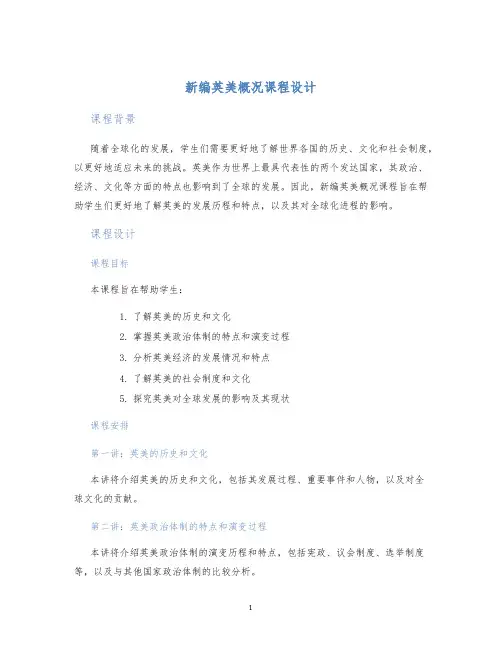
新编英美概况课程设计课程背景随着全球化的发展,学生们需要更好地了解世界各国的历史、文化和社会制度,以更好地适应未来的挑战。
英美作为世界上最具代表性的两个发达国家,其政治、经济、文化等方面的特点也影响到了全球的发展。
因此,新编英美概况课程旨在帮助学生们更好地了解英美的发展历程和特点,以及其对全球化进程的影响。
课程设计课程目标本课程旨在帮助学生:1.了解英美的历史和文化2.掌握英美政治体制的特点和演变过程3.分析英美经济的发展情况和特点4.了解英美的社会制度和文化5.探究英美对全球发展的影响及其现状课程安排第一讲:英美的历史和文化本讲将介绍英美的历史和文化,包括其发展过程、重要事件和人物,以及对全球文化的贡献。
第二讲:英美政治体制的特点和演变过程本讲将介绍英美政治体制的演变历程和特点,包括宪政、议会制度、选举制度等,以及与其他国家政治体制的比较分析。
第三讲:英美经济的发展情况和特点本讲将介绍英美经济的发展历程、特点和优劣,包括工业革命、金融业、国际贸易等,以及与其他国家经济的比较分析。
第四讲:英美的社会制度和文化本讲将介绍英美社会制度和文化,包括教育、医疗、福利、宗教等方面,以及与其他国家的比较分析。
第五讲:英美对全球发展的影响及其现状本讲将介绍英美对全球发展的影响,包括科技、文化、经济、政治等方面,以及对全球化进程的影响和现状的分析。
课程评估1.课堂考试:考核学生对于课程知识的掌握情况。
2.课堂讨论:鼓励学生进行课堂互动和合作,并对学生的表现进行评估。
3.课程论文:要求学生对课程内容进行深入研究和分析,完成一篇课程论文。
4.课堂作业:布置课堂作业,帮助学生巩固所学知识,加深对课程的理解。
参考资料1.美国史话(第四版,潘金菊)2.英国通史(第六版,韩爱晶)3.进入全球世界:新世界经济发展史(戈登·布朗, 丹尼斯·博夫金,亨利·罗斯伯)4.全球化与文化研究(第二版,李亚力)以上就是新编英美概况课程的设计和安排。

目录•引言•英国概况•美国概况•英美文化比较•英美教育制度•英美旅游资源•课程总结与展望引言01掌握英美两国的基本概况,包括地理、历史、政治、经济、文化等方面。
02提高学生对英美文化的敏感性和跨文化交际能力。
03培养学生的自主学习能力和批判性思维能力。
教学目标与要求教学内容概述01英国部分介绍英国的地理位置、历史发展、政治制度、经济概况、文化传统等。
02美国部分介绍美国的地理位置、历史发展、政治制度、经济概况、文化传统等。
03英美文化比较对比分析英美两国在文化、价值观、社会习俗等方面的异同。
讲授法通过教师的讲解,向学生传授英美概况的基本知识。
讨论法鼓励学生就相关话题进行讨论,提高学生的口语表达能力和批判性思维能力。
多媒体教学利用多媒体课件、视频等教学资源,增强学生的学习兴趣和体验感。
自主学习引导学生利用课外时间进行自主学习,培养学生的自主学习能力。
教学方法与手段英国概况自然环境英国地势西北高、东南低,主要山脉有奔宁山脉、格兰扁山脉和斯康迪纳维亚山脉的延伸部分;主要河流有泰晤士河、塞文河等;主要气候类型为温带海洋性气候。
地理位置英国位于欧洲大陆西北面的不列颠群岛,被北海、英吉利海峡、凯尔特海、爱尔兰海和大西洋包围。
地理位置与自然环境历史发展与文化传承历史发展英国历史经历了罗马时期、盎格鲁-撒克逊时期、维京入侵、诺曼征服、都铎王朝等重要阶段,形成了独特的文化传统。
文化传承英国文化深受基督教文化、日耳曼文化和法兰西文化的影响,形成了独特的文化体系,包括文学、艺术、音乐、戏剧等方面。
政治制度与经济体系01政治制度英国实行议会民主制,国王或女王为国家元首,但国家的实际治理权在议会和内阁手中。
02经济体系英国经济以服务业为主,包括金融、零售、旅游等方面;制造业和农业也占有重要地位。
社会生活与风俗习惯社会生活英国人注重礼仪和秩序,喜欢喝茶、看报纸、参加体育活动等。
风俗习惯英国有许多独特的传统和节日,如圣诞节、复活节、感恩节等;同时也有许多独特的礼仪和习俗,如穿正装、戴帽子等。
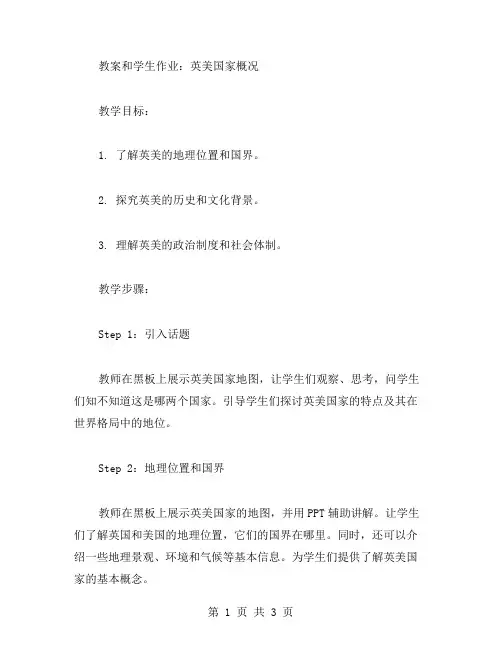
教案和学生作业:英美国家概况教学目标:1. 了解英美的地理位置和国界。
2. 探究英美的历史和文化背景。
3. 理解英美的政治制度和社会体制。
教学步骤:Step 1:引入话题教师在黑板上展示英美国家地图,让学生们观察、思考,问学生们知不知道这是哪两个国家。
引导学生们探讨英美国家的特点及其在世界格局中的地位。
Step 2:地理位置和国界教师在黑板上展示英美国家的地图,并用PPT辅助讲解。
让学生们了解英国和美国的地理位置,它们的国界在哪里。
同时,还可以介绍一些地理景观、环境和气候等基本信息。
为学生们提供了解英美国家的基本概念。
Step 3:历史和文化背景教师通过适当的阅读材料和幻灯片,向学生们介绍英美国家的历史和文化背景。
以英国为例,从古代到现代的不同阶段探究其中的历史、文学和艺术等方面的信息。
而对于美国,教师可以根据学生的兴趣和课程时间来选择合适的内容,例如美国独立战争、种族隔离的进程以及美国的民权运动等。
让学生们全面了解英美的文化背景,理解它们的文化内涵和传统精髓。
Step 4:政治制度和社会体制为学生们介绍英美国家的政治制度和社会体制,通过比较描绘,使学生们能够较为清晰地区分两国在政治制度和社会思维方面的异同点。
让学生们了解英美的政治制度和社会体制结构,探讨它们的优缺点和现状。
Step 5:做作业将学生分为小组,让他们在同学间交换信息、讨论、总结和归纳关于英美国家概况的各类成果。
再让学生以此作为素材,自由创作小作文或PPT,以展现对英美国家概况的真正了解。
讲解注意点:1. 注重课堂氛围与情感体验:教师在本节课中应当通过自身兴趣和情感传递来调动学生的思维和表达热情,激发学生的探究欲和积极性。
2. 借助多种现场教学方法和手段:通过旁听,图片展示,视频,话题引导,热身活动等许多不同的手段及议程形式,为学生提供知识点以外的多场景学习机会,协助学生增强对英美国家的了解,提升兴趣。
3. 含易于掌握和认识的信息:教学时可以适当加入一些有趣、容易理解的点,让学生掌握相关概念,如城市景观、有趣的历史人物故事等。
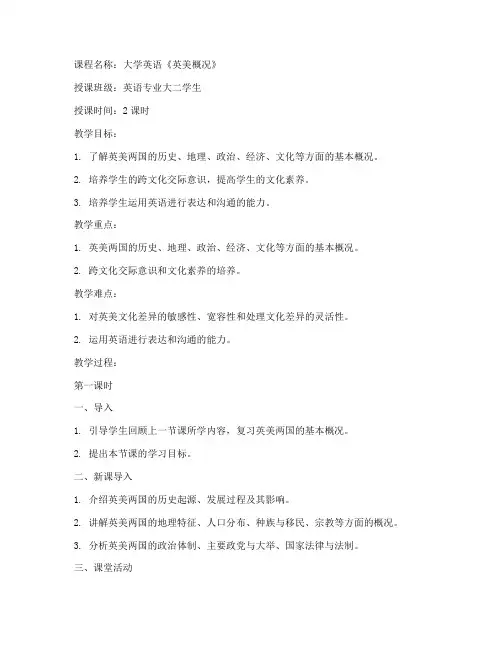
课程名称:大学英语《英美概况》授课班级:英语专业大二学生授课时间:2课时教学目标:1. 了解英美两国的历史、地理、政治、经济、文化等方面的基本概况。
2. 培养学生的跨文化交际意识,提高学生的文化素养。
3. 培养学生运用英语进行表达和沟通的能力。
教学重点:1. 英美两国的历史、地理、政治、经济、文化等方面的基本概况。
2. 跨文化交际意识和文化素养的培养。
教学难点:1. 对英美文化差异的敏感性、宽容性和处理文化差异的灵活性。
2. 运用英语进行表达和沟通的能力。
教学过程:第一课时一、导入1. 引导学生回顾上一节课所学内容,复习英美两国的基本概况。
2. 提出本节课的学习目标。
二、新课导入1. 介绍英美两国的历史起源、发展过程及其影响。
2. 讲解英美两国的地理特征、人口分布、种族与移民、宗教等方面的概况。
3. 分析英美两国的政治体制、主要政党与大举、国家法律与法制。
三、课堂活动1. 分组讨论:学生分成小组,就英美两国的文化差异进行讨论,分享自己的观点。
2. 角色扮演:模拟英美两国的日常生活场景,让学生运用英语进行对话。
四、总结1. 回顾本节课所学内容,强调英美两国的文化差异和跨文化交际意识的重要性。
2. 布置课后作业,要求学生查阅资料,了解英美两国的教育体系、家庭、社会福利及文化生活。
第二课时一、复习1. 回顾上一节课的课后作业,检查学生的学习成果。
2. 引导学生讨论英美两国的教育体系、家庭、社会福利及文化生活。
二、新课导入1. 讲解英美两国的经济分布、发展情况、经济产业和经济模式。
2. 分析英美两国的文化生活,如音乐、电影、艺术等。
三、课堂活动1. 分组讨论:学生分成小组,就英美两国的文化生活进行讨论,分享自己的观点。
2. 角色扮演:模拟英美两国的日常生活场景,让学生运用英语进行对话。
四、总结1. 回顾本节课所学内容,强调英美两国的经济和文化生活。
2. 布置课后作业,要求学生查阅资料,了解英美两国的历史名人、文学作品等。
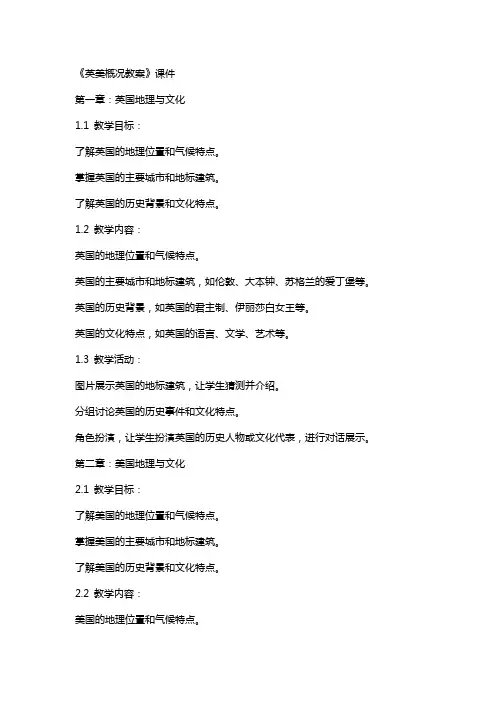
《英美概况教案》课件第一章:英国地理与文化1.1 教学目标:了解英国的地理位置和气候特点。
掌握英国的主要城市和地标建筑。
了解英国的历史背景和文化特点。
1.2 教学内容:英国的地理位置和气候特点。
英国的主要城市和地标建筑,如伦敦、大本钟、苏格兰的爱丁堡等。
英国的历史背景,如英国的君主制、伊丽莎白女王等。
英国的文化特点,如英国的语言、文学、艺术等。
1.3 教学活动:图片展示英国的地标建筑,让学生猜测并介绍。
分组讨论英国的历史事件和文化特点。
角色扮演,让学生扮演英国的历史人物或文化代表,进行对话展示。
第二章:美国地理与文化2.1 教学目标:了解美国的地理位置和气候特点。
掌握美国的主要城市和地标建筑。
了解美国的历史背景和文化特点。
2.2 教学内容:美国的地理位置和气候特点。
美国的主要城市和地标建筑,如纽约、自由女神像、华盛顿特区等。
美国的历史背景,如美国的独立战争、美国总统等。
美国的文化特点,如美国的语言、文学、艺术等。
2.3 教学活动:图片展示美国的地标建筑,让学生猜测并介绍。
分组讨论美国的历史事件和文化特点。
角色扮演,让学生扮演美国的历史人物或文化代表,进行对话展示。
第三章:英国教育体系3.1 教学目标:了解英国的教育体系和学校类型。
掌握英国的教育阶段和学历认证。
了解英国的高等教育特点。
3.2 教学内容:英国的教育体系和学校类型,如公立学校、私立学校、Technical and Further Education等。
英国的教育阶段和学历认证,如GCSE、A-Level、HND等。
英国的高等教育特点,如牛津大学、剑桥大学等。
3.3 教学活动:分组讨论英国的教育体系和学校类型。
案例分析,介绍牛津大学和剑桥大学等英国著名高校的特点。
角色扮演,让学生扮演英国的学生或教师,进行对话展示。
第四章:美国教育体系了解美国的教育体系和学校类型。
掌握美国的教育阶段和学历认证。
了解美国的高等教育特点。
4.2 教学内容:美国的教育体系和学校类型,如公立学校、私立学校、Community College 等。
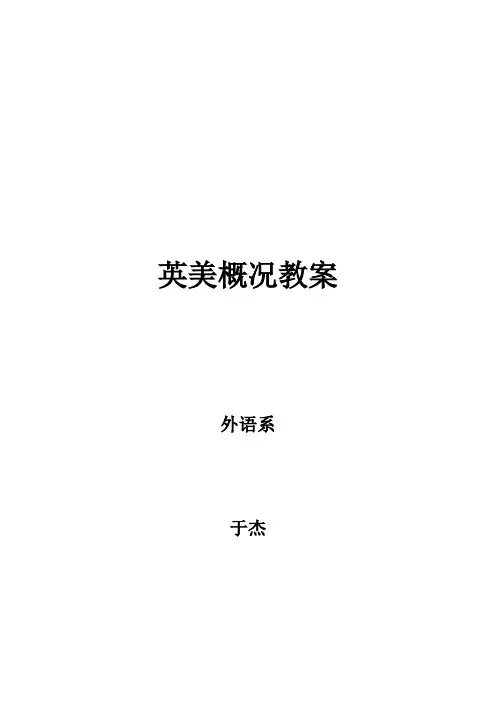
英美概况教案(一)【教学目标】1. 了解英国和美国的基本地理、历史和文化概况。
2. 掌握英国和美国的主要城市、名胜古迹和自然资源。
3. 了解英国和美国的政治体制、教育制度和社会福利。
【教学内容】1. 英国的地理位置和地形特点。
2. 英国的历史概况:罗马时期、中世纪、工业革命、现代英国。
3. 英国的主要城市:伦敦、曼彻斯特、爱丁堡、伯明翰等。
4. 英国的名胜古迹:大本钟、白金汉宫、伦敦塔桥、牛津大学等。
5. 英国的自然资源:苏格兰高地、湖区国家公园、威尔士山脉等。
【教学方法】1. 采用多媒体教学,展示英国的地理位置、城市和名胜古迹的图片和视频。
2. 通过讲解和讨论的方式,让学生了解英国的历史、政治和社会文化。
3. 设置小组任务,让学生调查英国的自然资源和旅游特色。
【教学评估】1. 课堂讨论:学生能积极参与讨论,表达对英国的了解和看法。
2. 小组报告:学生能完成调查任务,呈现英国的自然资源和旅游特色。
3. 课后作业:学生能完成相关阅读材料,加深对英国的了解。
英美概况教案(二)【教学目标】1. 了解美国的基本地理、历史和文化概况。
2. 掌握美国的主要城市、名胜古迹和自然资源。
3. 了解美国的政治体制、教育制度和社会福利。
【教学内容】1. 美国的地理位置和地形特点。
2. 美国的歷史概况:殖民时期、独立战争、南北战争、现代美国。
3. 美国的主要城市:纽约、洛杉矶、旧金山、芝加哥等。
4. 美国的名胜古迹:自由女神像、白宫、国会山、哈佛大学等。
5. 美国的自然资源:大峡谷、黄石国家公园、尼亚加拉大瀑布等。
【教学方法】1. 采用多媒体教学,展示美国的地理位置、城市和名胜古迹的图片和视频。
2. 通过讲解和讨论的方式,让学生了解美国的历史、政治和社会文化。
3. 设置小组任务,让学生调查美国的自然资源和旅游特色。
【教学评估】1. 课堂讨论:学生能积极参与讨论,表达对美国的了解和看法。
2. 小组报告:学生能完成调查任务,呈现美国的自然资源和旅游特色。
新编英美概况教学设计1. 简介本教学设计旨在帮助学生了解并较全面地认识英美两国的历史、政治、文化等方面内容。
通过学习,学生能够掌握英美两国的基本情况,培养跨文化交流能力和视野拓展能力。
2. 教学目标•了解英美两国的历史、政治、文化等方面内容•能够对英美两国的文化进行比较分析•培养学生的跨文化交流能力和视野拓展能力3. 教学内容3.1 历史•英美两国的历史演变•英美两国的历史事件及其影响3.2 政治•英美两国的政治制度和组织结构•英美两国的政治制度比较分析3.3 文化•英美两国的文化背景与代表人物•英美两国的文化比较分析4. 教学方法本教学设计采用多种教学方法,包括但不限于:•讨论•观看影片•研讨5. 教学流程5.1 第一节课内容:•英美两国历史演变•英美两国历史事件及其影响教学方法:•讲授•讨论教学流程:1.简单介绍英美两国的历史背景和发展2.对学生进行历史事件的讲解,并分组讨论事件的影响3.整合讨论结果,回答学生的问题5.2 第二节课内容:•英美两国的政治制度和组织结构•英美两国的政治制度比较分析教学方法:•讲授教学流程:1.简单介绍英美两国的政治制度和组织结构2.以小组为单位进行英美两国政治制度比较分析3.整合分组讨论的结果,回答学生的问题5.3 第三节课内容:•英美两国文化背景与代表人物•英美两国文化比较分析教学方法:•讲授•观看影片•研讨教学流程:1.简单介绍英美两国的文化背景和代表人物2.观看相关影片3.对学生进行研讨,进行英美两国文化比较分析4.整合讨论结果,回答学生的问题6. 教学评估教学评估包括两种方式,分别是定量评估和定性评估。
其中,定量评估主要通过考试、问卷调查等方式来进行,以期了解学生对教学内容的掌握情况;定性评估则主要通过教师和学生的课后反思、思考,以期获得教学过程的反馈意见。
两种评估方式相结合,能够全面、准确地反映教学质量。
7. 教学资源•PPT演示文稿•音频、视频资料•教材和参考书籍8. 教学总结通过本教学设计,学生能够全面、较为全面地了解并认识英美两国的历史、政治、文化等方面内容,培养跨文化交流能力和视野拓展能力。
新编英美概况第三版教学设计概述本文档是对新编英美概况第三版教学设计的详细说明。
新编英美概况是一门介绍英国和美国历史、文化、政治、经济、教育等方面的综合性课程,在帮助学生全面了解英美国家的同时,也可以帮助学生进一步提高英语水平和跨文化交流能力。
教学目标本门课程的教学目标如下:1.帮助学生了解英美国家的历史、文化、政治、经济、教育等方面;2.帮助学生提高英语听说读写能力,掌握英语学习方法;3.帮助学生增强跨文化交流能力,促进国际交流与合作。
教学内容本门课程的教学内容如下:第一章英国概况1.英国历史概述;2.英国政治体系;3.英国文化与艺术;4.英国经济现状;5.英国教育体系。
第二章美国概况1.美国历史概述;2.美国政治体系;3.美国文化与艺术;4.美国经济现状;5.美国教育体系。
教学方法本门课程采用多种教学方法,包括但不限于:1.课堂讲授:由教师讲解知识点和相关概念,学生跟随教师思路整合学习;2.课堂讨论:教师提出问题或主题,学生自由组合讨论,开展交流;3.小组合作:教师组织学生进行小组活动,加强互动、合作和交流;4.课外拓展:组织学生参观实地、文化体验、社交交往等形式地拓展。
教学评价本门课程采用多种方式对学生进行教学评价:1.平时成绩:包括出勤情况、作业完成情况、课堂表现等;2.期中考试:主要考察学生对课程内容的掌握情况;3.期末考试:主要考察学生对课程内容的整体掌握情况;4.课程作业:包括单选题、多选题、填空题、简答题等。
总结新编英美概况第三版教学设计是一份对这门课的详细说明,旨在帮助教师更好地进行教学。
教学内容囊括了英国和美国的历史、文化、政治、经济、教育等方面,教学方法注重学生的互动、合作和交流。
对学生的教学评价包括平时成绩、期中考试、期末考试和课程作业。
这门课将为学生提供一次深度了解英美国家和提高英语水平的机会。